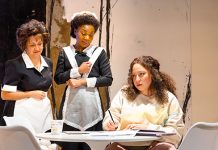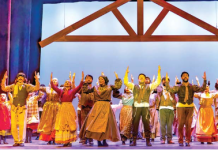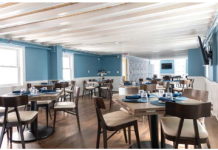By Linda McK.Stewart
No presidential library was ever designed on a “warts and all” concept. So it’s no surprise that the Ronald Reagan Presidential Library and Museum, the nation’s largest and most expensive presidential library, is an unapologetic paean to our 40th president.
This 100-acre, multimillion-dollar complex, funded entirely by private donations, is 50 miles northwest of Los Angeles and crowns a lofty mountaintop. The site affords incredible panoramic views of the hills of Simi Valley out to the far-off, shimmering Pacific Ocean.
A visit begins in a spacious courtyard of Spanish mission style. From the courtyard you enter a large airy reception area attended by a uniformed, forever-cheery staff. First comes the introductory film. Departing the minitheater you enter a sequence of 24 compartmentalized galleries, small in scale, intimate in style. In contrast to so many history-related venues, this is definitely not a place where mobs of people shuffle down long corridors, straining to see glass-fronted displays.

It doesn’t hurt that Reagan, right from the first, was such a happy, handsome specimen of humanity. There he sits in black and white with Pa, Ma and baby brother, Neil, on the porch steps of their modest clapboard house in Tampico, Ill., where he was born in 1911. In his midteens, wearing a big grin plus his two-piece, woolen lifeguard bathing suit, he poses by a lake in Dixon, Ill. It’s the very lake from which, in his seven years of lifeguarding, he is credited with hauling in more then 60 hapless swimmers. At Eureka College he’s not only a football hero, but the duly elected president of student government. College is followed by a successful career as a radio announcer. Excused from active service in World War II by nearsightedness, he makes training films as a member of the American Air Force.
Then came his career as a Hollywood actor and the presidency from 1947-52 of the Screen Actors Guild. It seems a short hop from president of SAG to the governor’s mansion in Sacramento and thence to 1980 and to the White House.
Nancy Reagan, her life and times, are well-covered. A large glass case holds a handsome array of stylish outfits, including several lavish ball gowns. Jane Wyman, wife No. 1, discreetly slips by with but the briefest of nods.
It’s 1983 and there he sits in the Rose Garden, welcoming (who remembered!) Sandra Day O’Connor, first female appointee to the Supreme Court. The nasty business of the Iran-Contra affair rates minimal attention, best summed up in 1987 by Reagan’s contention that he knew nothing about it and anyway, really no one was to blame.
Juvenile boredom is held at bay by any number of photo ops. Who wouldn’t want to be snapped atop a full-size plastic horse, against a background of RR himself astride a favorite steed, grinning over your shoulder.
Ever wonder how it would feel to deliver an inaugural address via teleprompter? Then step right up to the rostrum and speak directly into the mike with a trio of teleprompters displaying your speech, phrase by phrase.
One particularly memorable exhibit invites visitors, only a few at a time, into a small, darkened room. On a life-size screen the sequence of events that in 1981 was the assassination attempt of the only recently elected president plays out in six seconds: The president emerges from the hotel to cross the sidewalk, shots ring out, figures fall. The screen darkens. Lights come on. How many shots were fired? Four? Two? Six? There’s no consensus.
It’s chilling proof of how unreliable can be the testimony of any eyewitness. The gun used by John Hinckley. Jr. is on display in a glass case. It’s no larger than the palm of your hand. It could easily be mistaken for something on sale at Toys ‘R’ Us.

Visitors are treated to an exact re-creation of the Oval Office as it existed during the Reagan presidency. “Note the earth tones,” the guide points out, “and, of course, the jar of jelly beans on the presidential desk.” Over the mantle, unremarked by the guide, but well worth a moment’s consideration, is a portrait of a young George Washington in militia dress on duty fighting with the British against the French at Fort Duquesne in 1758.
From the Oval Office you file down a long glass corridor to Air Force One Pavilion, all 90,000 square feet of it. There in all its awesome size is the Boeing 707 jumbo jet that served President Reagan and six other presidents.

It’s the ultimate photo op! Climb the steps, turn in the doorway for the obligatory wave, (forever captured on your souvenir photo for only $15) and then file through the plane. No photography please! Then much gaping – No Touching! – at all the perks that serve every chief executive: bedroom, shower, dining room, press room and, of course, in Reagan’s day, a huge jar of jelly beans. James Gardner, newly appointed executive of presidential libraries, calls the Reagan library: “A perfect balance between history and memory.”
Which of course begs the question: Yes, but whose memory?
IF YOU GO: For further information concerning the Reagan Library, call 805-390-6405.














